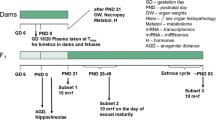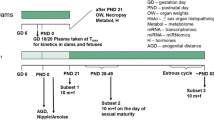Abstract
Although zearalenone (ZEN; Sigma Chemicals, St Louis, Missouri) is a well-known mycotoxin with estrogenic activity, the toxic effects of ZEN during pregnancy are unknown. This study compared the effects of daily subcutaneous injections of ZEN (2, 4, or 8 mg/kg) with those of 17β-estradiol (E2; [Sigma Chemicals] 0.8, 1.6, or 3.2 μg/kg) in mice. Injections were administered on gestational days (GDs) 1 to 5, the period including implantation which is sensitive to hormonal balance. The effects of ZEN or E2 were evaluated by comparing the number of live fetuses, their weight, and absorbed conceptuses on GD 18, with those in vehicle-treated controls. In addition, implantation, embryos in the oviducts and those in uteri without implantation sites were investigated on GD 5. In mice treated with the highest dose of ZEN or E2, decidual responses and plasma progesterone concentrations were measured on GDs 5 and 6, respectively, and delayed implantation was investigated on GDs 9 and 14. The results showed that treatment with ZEN, in a manner similar to that seen for E2, led to obstruction of essential processes for establishing and maintaining pregnancy, such as embryo migration from oviducts to uteri, the decidual response, and activation of luteal function. Zearalenone also induced delayed implantation and loss of conceptuses and at low doses caused a retarded growth of the fetuses after normal implantation. It was therefore concluded that ZEN causes multiple estrogenic toxic actions when administered during early pregnancy in mice.
Similar content being viewed by others

References
Placinta CM, D’Mello JPF, Macdonald AMC. A review of worldwide contamination of cereal grains and animal feed with Fusarium mycotoxins. Anim Feed Sci Technol. 1999;78(1-2):21–37.
Zinedine A, Soriano JM, Molto JC, Manes J. Review on the toxicity, occurrence, metabolism, detoxification, regulations and intake of zearalenone: an oestrogenic mycotoxin. Food Chem Toxicol. 2007;45(1):1–18.
JECFA. Zearalenone. In: Joint FAO/WHO Expert Committee on Food Additives, eds. Safety Evaluation of Certain Food Additives and Contaminants. Geneva, Switzerland: WHO/FAO Food additives Series 44. IPCS-International Programme on Chemical Safety. WHO; 2000.
Kuiper-Goodman T, Scott PM, Watanabe H. Risk assessment of the mycotoxin zeararelone. Regul Toxicol Pharmacol. 1987;7(3):253–306.
Biehl ML, Prelusky DB, Koritz GD, Hartin KE, Buck WB, Trenholm HL. Biliary excretion and enterohepatic cycling of zearalenone in immature pigs. Toxicol Appl Pharmacol. 1993;121(1):152–159.
Malekinejad H, Maas-Bakker RF, Fink-Gremmels J. Species differences in the hepatic biotransformation of zearalenone. Vet J. 2006;172(1):96–102.
Olsen M, Pettersson H, Sandholm K, Visconti A, Kiessling K-H. Metabolism of zearalenone by sow intestinal mucosa in vitro. Food Chem Toxicol. 1987;25(9):681–683.
Long GG, Diekman MA. Effect of purified zearalenone on early gestation in gilts. J Anim Sci. 1984;59(6):1662–1670.
Long GG, Diekman MA. Characterization of effects of zearalenone in swine during early pregnancy. Am J Vet Res. 1986;47(1):184–187.
Long GG, Turek J, Diekman MA, Scheidt AB. Effect of zearalenone on GDs 7 to 10 post-mating on blastocyst development and endometrial morphology in sows. Vet Pathol. 1992;29(1):60–67.
Long GG, Diekman MA. Effect of zearalenone on early pregnancy in guinea pigs. Am J Vet Res. 1989;50(8):1220–1223.
Brooks JR, Steelman SL, Patanelli DJ. Uterotropic and anti-implantation activities of certain resorcylic acid lactone derivatives. Proc Soc Exp Biol Med. 1971;137(1):101–104.
Zhang Y, Jia Z, Yin S, et al. Toxic effects of maternal zearalenone exposure on uterine capacity and fetal development in gestation rats. Reprod Sci. 2014;21(6):743–753.
Cha J, Sun X, Dey SK. Mechanisms of implantation: strategies for successful pregnancy. Nat Med. 2012;18(12):1754–1767.
Mueller SO, Simon S, Chae K, Metzler M, Korach KS. Phytoestrogens and their human metabolites show distinct agonistic and antagonistic properties on estrogen receptor α (ERα) and ERβ (ERβ) in human cells. Toxicol Sci. 2004;80(1):14–25.
Dyer RG, Mansfield S. Anaesthesia with alphaxalone plus alphadolone acetate blocks the oestrogen-stimulated LH surge and impairs pulsatile LH secreation in ovariectomized female rats. J Endocrinol. 1984;102(1):27–31.
Kilpatrick MJ, Donovan BT. Effect of anesthesia on the negative feedback action of gonadal steroids on gonadotrophin secretion in the ovariectomized guinea-gig. J Endocrinol. 1981;89(1):167–177.
Cruz ME, Flores A, Palafox MT, et al. The role of the muscarinic system in regulating estradiol secretion varies during the estrous cycle: the hemiovariectomized rat model. Reprod Biol Endocrinol. 2006;4:43.
Zhang X, Yu M, Yu W, Weinberg J, Shapiro J, McElwee KJ. Development of alopecia areata is associated with higher central and peripheral hypothalamic-pituitary-adrenal tone in the skin graft induced C3H/Hej mouse model. J Invest Dermatol. 2009;129(6):1527–1538.
Solano ME, Kowal MK, O’Rourke GE, et al. Progesterone and HMOX-1 promote fetal growth by CD8+ T cell modulation. J Clin Invest. 2015;125(4):1726–1738.
Collins TFX, Sprando RL, Black TN, et al. Effects of zearalenone on in utero development in rats. Food Chem Toxicol. 2006;44(9):1455–1465.
Yeo S-H, Herbison AE. Estrogen-negative feedback and estrous cyclicity are critically dependent upon estrogen receptor-α expression in the arcuate nucleus of adult female mice. Endocrinology. 2014;155(8):2986–2995.
Roblero LS, Moscoso HE, Fiffo M. Effect of postcoital oestradiol treatment upon transport, growth, differentiation and viability of preimplantation mouse embryos. Arch Biol Med Exp. 1983;16(1):55–59.
Huet-Hudson YM, Dey SK. Requirement for progesterone priming and its long-term effects on implantation in the mouse. Proc Soc Exp Biol Med. 1990;193(4):259–263.
Author information
Authors and Affiliations
Corresponding author
Rights and permissions
About this article
Cite this article
Kunishige, K., Kawate, N., Inaba, T. et al. Exposure to Zearalenone During Early Pregnancy Causes Estrogenic Multitoxic Effects in Mice. Reprod. Sci. 24, 421–427 (2017). https://doi.org/10.1177/1933719116657194
Published:
Issue Date:
DOI: https://doi.org/10.1177/1933719116657194



